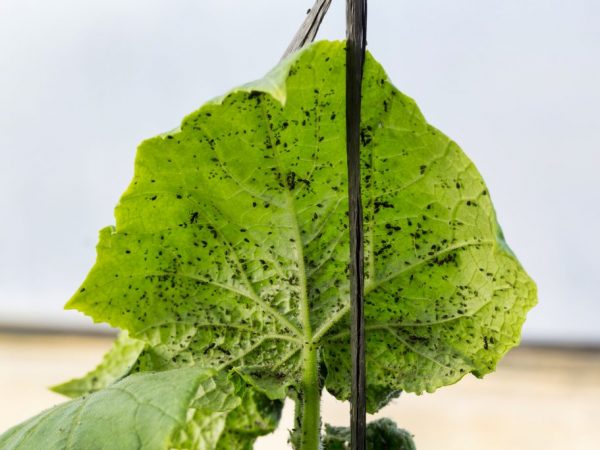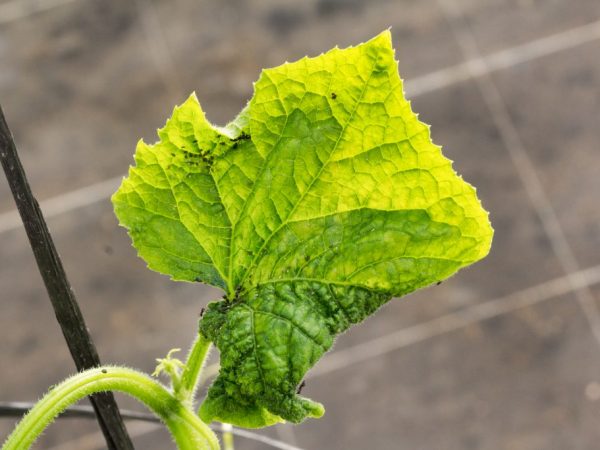How to deal with aphids on cucumbers at home
Of all the harmful insects, aphids most often attack cucumbers. It is capable of causing significant damage to the crop, so it is very important to take timely measures to combat this pest. Consider how to deal with aphids on cucumbers and what preventive measures should be taken so that the insect does not appear at all on the garden plot.
- Aphid control methods
- Chemical methods
- Traditional methods
- Soap solution
- Remedy with ammonia
- Ash-soap solution
- Infusion of potato tops
- Infusion of tomato tops
- Garlic infusion
- Vinegar remedy
- Biological methods
- Preventive measures
- Getting rid of weeds
- Disinsection of soil
- Compliance with planting standards
- Feeding cucumbers
- Change of landing place
- Conclusion

Fighting aphids at home
Aphid control methods
All aphid control methods are divided into 3 groups:
- chemical;
- biological;
- folk.
Chemical methods are the most effective, but they are not always applicable. The advantage of biological and folk methods of dealing with harmful insects is their harmlessness. They are not always effective. To understand when it is better to use chemical, and when, for example, biological methods of control, we will consider each group separately.
Chemical methods
Chemical control methods involve the use of insecticides. It is difficult to say which remedy for aphids on cucumbers is the most effective. It all depends on the type of parasitic insect, the climatic conditions of the region and the degree of infection of the vegetable crop. The most dangerous is the black aphid, which can destroy the entire crop in a short time.
Today, Commander, Corada and Aktar products are popular. The first two help to get rid of not only aphids, but also Colorado beetles. Aktara is considered one of the most effective fast acting insecticides. In addition, it has a prolonged effect, protecting the vegetable crop for a month after processing.
All insecticides contain substances harmful to the human body, therefore, they cannot be used immediately before harvesting. The instructions for each drug indicate how long before harvesting it can be used. If it is too late to use drugs, folk recipes and biological methods remain in the arsenal.
It is necessary to spray a vegetable crop in personal protective equipment. Do not allow insecticides to enter the respiratory tract.
Traditional methods
Let's focus on the most effective means that are used to combat this pest.
Soap solution
Its detrimental effect on harmful insects is easy to explain. Enveloping the body of aphids, the soap solution deprives the insects of the ability to breathe, which leads to their death.
To prepare a soap solution, you need about 300 g of laundry soap and 8-10 liters of water. The soap is simply dissolved in water. Liquid soap is an alternative to household soap, but it is taken 3 times less. It is best to process plants after the sun begins to set.
If it rains after treatment, it must be repeated.
Remedy with ammonia
This is another simple recipe that is easy to make at home. You will need 10 liters of water, 35-40 ml of ammonia, a small amount of laundry soap. All components are mixed. Soap is added so that the product does not drip from the leaves of the plant, but envelops them.
It is best to treat this planting agent with a spray bottle or a special sprayer.
Ash-soap solution

Soap will help fight insects
The protection of cucumbers from aphids with this drug has passed the test of time. It is used not only for pest control, but also for protecting cucumbers from many diseases. For cooking, we need 10 liters of hot water and 300 g of ash. The solution is put on fire and brought to a boil. Then turn off the heat and add laundry soap (100-200 g) to the slightly cooled mixture. It is necessary to spray the cucumber leaves with this product after it has been infused for several hours.
Infusion of potato tops
This effective remedy is easy to make at home, but the necessary ingredients are not always on hand, so there should be some dried potato tops in the cellar.
To prepare a bucket of infusion, you will need 700 g of dried tops. If there is fresh, take 1 kg. The tops are soaked in water and left for 3 hours. At the end of this time, the infusion is ready for use. You should first sprinkle the strained infusion on the affected plants.
Infusion of tomato tops
This tool helps to get rid of not only aphids on cucumbers, but also from moths, apple stalks, scale insects, herbivorous bugs. To prepare the product, you will need 5 liters of boiling water and 2 kg of dry tops of tomatoes. If the product is prepared from fresh tops, they take about 5 kg. The tops are poured with boiling water and put on the fire, and then boiled for 30 minutes, after which they are removed from the heat and insisted for 30-40 minutes. Before spraying the affected plants, the infusion is diluted with boiled water (for 1 part of the infusion, take 3 parts of water).
If the container with the infusion is tightly closed with a lid, it can be stored for several months.
Garlic infusion
With this tool, you can fight almost all parasitic insects. To prepare it, you will need 200 g of cloves and 1 liter of water. Chop the chives and cover them with water. Close the dishes used for preparing the infusion tightly with a lid and leave for 5 days. After this time, the product is ready for use.
The fight against melon aphids on cucumbers, and it is this type of aphid that seizes this vegetable crop in summer, involves the use of a weakly concentrated garlic infusion, therefore, the prepared product is diluted with water before use (250 ml of infusion is taken for 10 liters of water). If you fight a harmful insect with a concentrated infusion, you can burn the leaves of the plant.
Vinegar remedy
If a melon aphid attacked the planting, it can also be expelled with ordinary vinegar. To prepare the drug, in addition to vinegar, you will need water. Both components are taken in equal proportions. With this tool, the leaf plates are sprayed from a spray bottle. It should not be cooked for the future.
It is not always possible with this drug to destroy the melon aphid the first time, especially if the vegetable crop is grown in the open field, so the treatment should be repeated after a few days.
All of the above means are used both during the flowering period and during the fruiting period of the vegetable crop. Within a few days after processing, they boldly harvest and eat them. The only exceptions are herbal infusions, which can contain small amounts of toxic substances. They are used to process cucumbers at least 2-3 weeks before harvesting.
It is necessary to process cucumber leaves not only from above, but also from below, because it is there that the largest number of pests is located.
Biological methods

Get rid of ants in the area
This is perhaps the most difficult method of dealing with this parasite. The natural enemy of aphids is the ladybug, so you need to create all the conditions so that ladybugs become a frequent guest at their summer cottage. Plants such as mustard and dill attract their attention, so they should be planted near cucumber beds.
But the companion insects for aphids are ants, which eat the waste products of these parasitic insects, which are sweetish in taste. That is why the destruction of anthills also belongs to biological methods of control. You can get rid of ants on the site by flooding it with boiling water, a concentrated solution of boric acid, or covering it with hot ash.
Preventive measures
In order not to think about how to process cucumbers from aphids, you need to follow a few simple rules.
Getting rid of weeds
It is possible to protect cucumbers from aphids by watching other plantings. This insect does not disdain weeds, so it is important to keep the site clean. Weeds should be removed not only on the site, but also near the fence from the street side.
Disinsection of soil
After harvesting, soil pest control is done. To do this, it is enough to treat the soil with chemicals that are sold in specialized stores. Many gardeners refuse to treat the soil with insecticides, because they contain substances harmful to the body, but in fact, all substances that negatively affect the body disintegrate during the winter. Accordingly, the entire crop obtained from the previously treated area does not contain substances hazardous to health.
Compliance with planting standards
Most often, aphids on cucumbers appear with overly thickened plantings, therefore, the scheme for planting cucumbers must be followed. Seed packages indicate how much distance should be between bushes and between beds. In some cases, it is advisable to remove part of the leaf plates so that the sun and wind have access to the plants.
Feeding cucumbers
Weak plants are most susceptible to various diseases and pests, so one should not forget to apply complex fertilizers in a timely manner. Most of all, the culture needs potassium and phosphorus - these trace elements must be present in the composition of mineral complexes. Organic fertilizers are applied several times per season.
Change of landing place
If cucumbers grow in the same place from year to year, they are more susceptible to attack by the same parasites. Accordingly, you can protect a vegetable crop simply by changing the planting site.
Conclusion
We looked at how to destroy aphids on cucumbers. The methods for controlling aphids in the open field and in the greenhouse are the same, but it is much easier to expel the pest from the greenhouse.
All windows and doors are closed prior to processing. The greenhouse is not ventilated for 24 hours after. If it was not possible to destroy the aphids the first time, the treatment is repeated.


